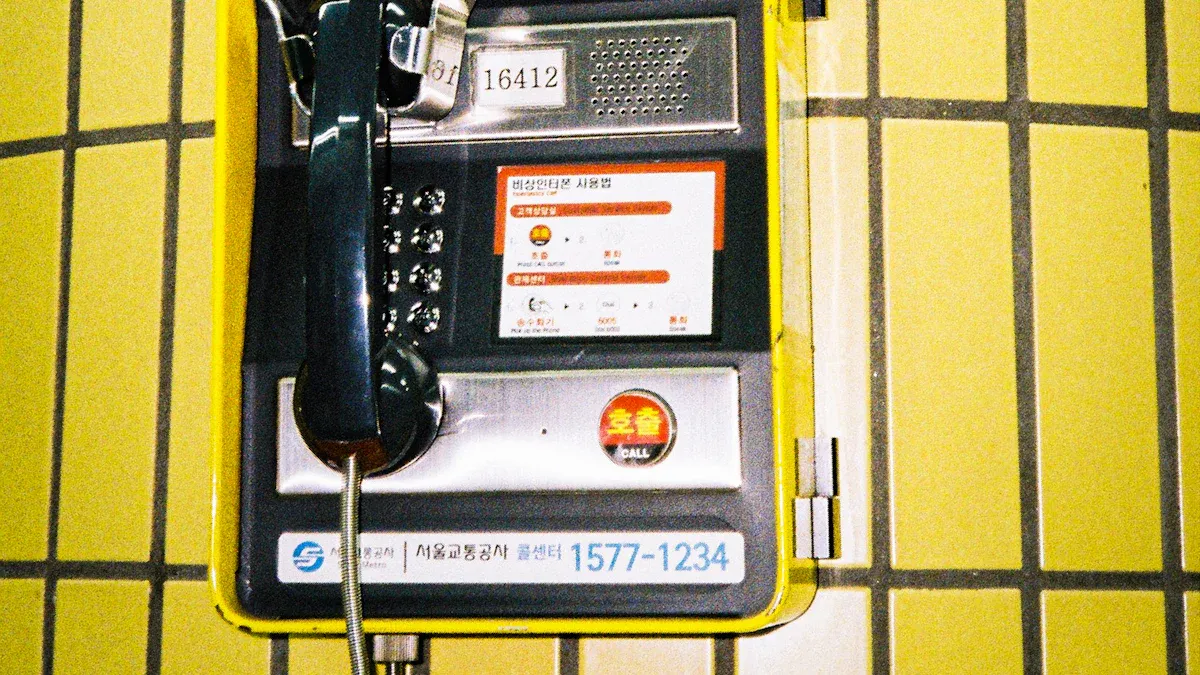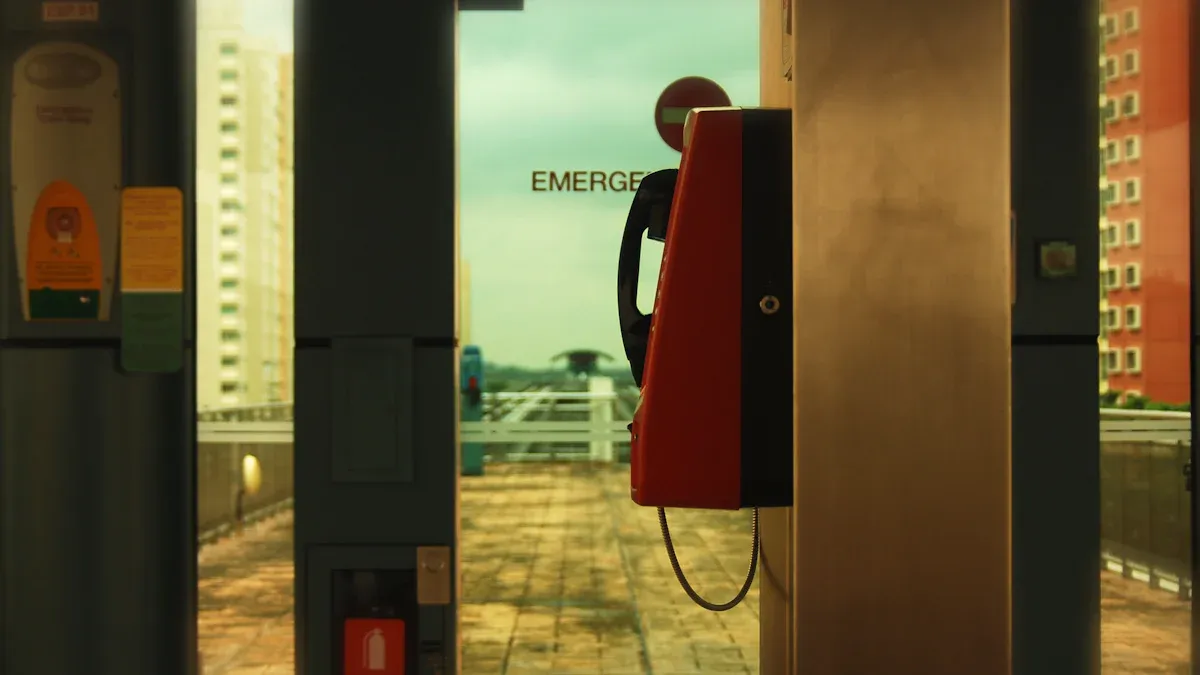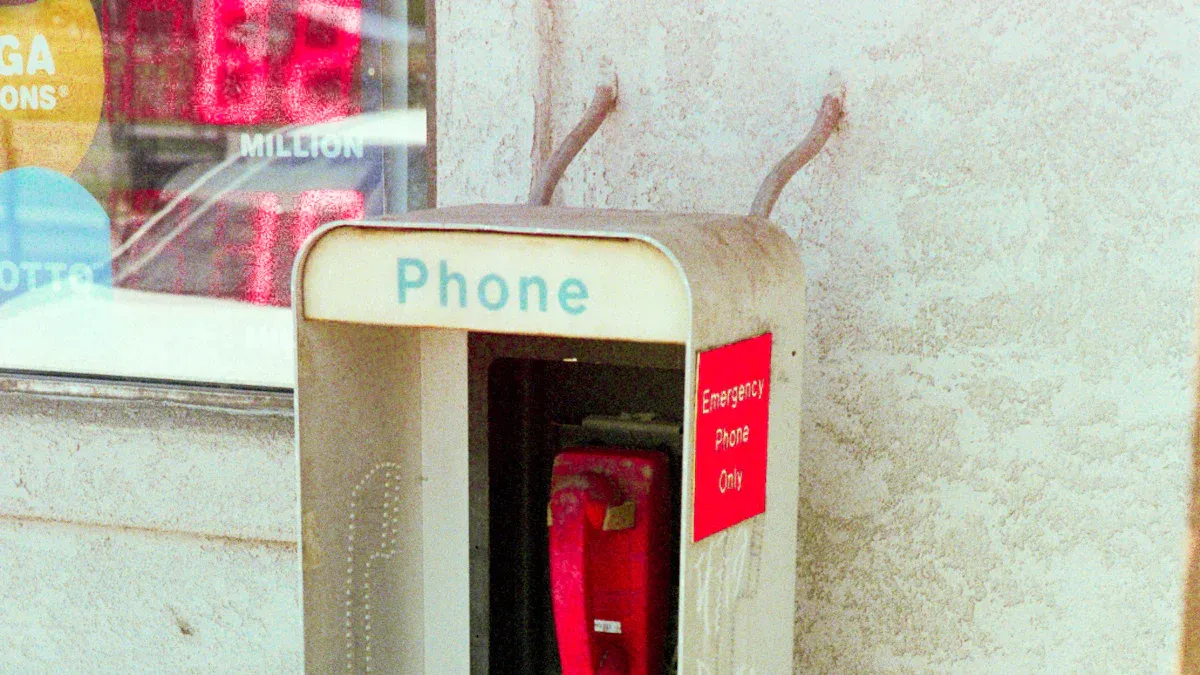
Emergency phones play a vital role in keeping industrial spaces safe. They ensure fast communication during crises. Whether it’s a rugged emergency telephone built for extreme conditions or an auto dial emergency telephone for instant calls, these devices provide life-saving support. An industrial heavy duty telephone or SOS emergency telephone can make all the difference.
Types of Emergency Phones

Emergency phones come in various types, each designed to meet specific needs. Choosing the right one depends on the environment and the level of connectivity required. Let’s explore the most common options.
Wired Emergency Phones
Wired emergency phones are a classic choice for industrial settings. These phones rely on physical cables, such as CAT-5 or analog lines, to establish a connection. Their reliability makes them ideal for areas where consistent communication is critical, like factories or tunnels. Wired systems are less prone to interference, ensuring clear communication even in noisy environments.
Tip: Wired phones are perfect for locations with existing infrastructure, as they can integrate seamlessly without additional setup.
Wireless Emergency Phones
Wireless emergency phones offer flexibility and convenience. They don’t require extensive cabling, making them suitable for outdoor spaces like parks, parking lots, or campgrounds. These phones are easy to install and relocate, which is a big advantage for temporary setups or areas with changing layouts. However, they depend on strong signal coverage to function effectively.
- Common uses for wireless phones:
- School campuses
- Sports facilities
- Corporate campuses
- Military camps
IP-Based Emergency Phones
IP-based emergency phones are the most advanced option. They use internet protocols to connect, offering features like scalability, integration, and future-proofing. For example, these phones can work with SIP-based systems, unifying communication across platforms. They also allow for software upgrades, ensuring they stay up-to-date with evolving needs.
| Benefit | Description |
|---|---|
| Cost Savings | Compatible with existing systems, reducing replacement costs. |
| Scalability | Easily expand coverage without new cabling. |
| Integration | Seamlessly connects with other communication systems. |
| Future-proofing | Software updates enable feature enhancements over time. |
IP-based phones are ideal for organizations looking to invest in long-term, adaptable solutions.
Key Features of a Rugged Emergency Telephone
When choosing a rugged emergency telephone, it’s essential to focus on features that ensure reliability in demanding environments. These phones are designed to withstand harsh conditions while providing dependable communication during emergencies. Let’s explore the key features that make them indispensable.
Weather Resistance and High IP Ratings
A rugged emergency telephone must endure extreme weather conditions, from heavy rain to intense heat. High IP (Ingress Protection) ratings indicate how well the device resists water and dust. For example:
| IP Rating | Description |
|---|---|
| IPX7 | Can be submerged in up to 1 meter of water for 30 minutes without damage. |
| IPX8 | Allows for submersion in more than 1 meter of water for a specified duration. |
| IP68 | Fully immersible beyond 1 meter for prolonged periods, also dustproof. |
Phones with IP68 ratings are ideal for industrial sites exposed to water, dust, or both. This level of protection ensures the phone remains operational even in the harshest environments.
Tip: Always check the IP rating to match the phone’s capabilities with the environmental challenges it will face.
Industrial-Grade Durability
Durability is non-negotiable for emergency phones in industrial settings. These devices must withstand physical impacts, vibrations, and extreme temperatures. Standards like MIL-STD-810H validate their toughness under various conditions. Here’s a quick comparison of durability levels:
| Standard/Rating | Description |
|---|---|
| MIL-STD-810H | Military standard for testing durability under various environmental conditions. |
| IP68 | Dustproof and waterproof rating, allowing submersion in water up to 1.5 m for 30 minutes. |
Levels of durability can also be categorized as:
- Durable: Suitable for basic ruggedness needs.
- Rugged: Designed for more extreme conditions.
- Ultrarugged: Built to military-grade standards for the harshest environments.
A rugged emergency telephone with ultrarugged features ensures long-term reliability, even in high-impact zones like construction sites or mining operations.
ADA Compliance and Accessibility
Accessibility is crucial for emergency phones, especially in public spaces. ADA (Americans with Disabilities Act) compliance ensures that these devices are usable by everyone, including individuals with disabilities. Features like braille instructions, large buttons, and hands-free operation make these phones more inclusive.
Note: ADA-compliant phones are not just a legal requirement in many areas—they also demonstrate a commitment to safety and inclusivity.
Noise-Canceling Technology
Industrial environments are often noisy, which can make communication challenging. Noise-canceling technology filters out background sounds, ensuring clear conversations even in loud settings like factories or airports. This feature is especially important for emergency situations where every second counts.
Power Backup Options
Power outages are common during emergencies, so a reliable power backup is essential. Many rugged emergency telephones come with built-in battery backups or alternative power sources like solar panels. These options ensure the phone remains operational when the primary power supply fails.
Pro Tip: Look for phones with long-lasting battery backups to avoid interruptions during critical moments.
Strategic Placement Considerations

Choosing the right location for emergency phones is just as important as selecting the right device. Strategic placement ensures these phones are accessible when needed most. Below are key considerations for placing emergency phones effectively.
High-Traffic Areas
Emergency phones should be installed in areas where people gather or pass through frequently. High-traffic zones like building entrances, hallways, or parking lots are ideal. These locations increase the chances of someone spotting the phone during an emergency.
Tip: Place phones near exits or intersections where they are easy to find. This ensures quick access in critical moments.
In industrial settings, high-traffic areas might include factory floors or break rooms. These spots often have more people, making it easier to get help quickly.
Hazardous Zones
Hazardous zones require special attention. These areas include construction sites, chemical plants, or locations with heavy machinery. Emergency phones in these zones must be durable enough to withstand harsh conditions. A rugged emergency telephone is perfect for such environments. It can handle extreme temperatures, dust, and even physical impacts.
- Examples of hazardous zones:
- Mining sites
- Oil refineries
- Power plants
Phones in these areas should also be placed at safe distances from potential dangers. For instance, in a chemical plant, phones should be located outside the immediate spill zone but still within reach.
Visibility and Accessibility
An emergency phone is only useful if people can find it quickly. Phones should be placed in visible locations with clear signage. Bright colors like red or yellow can make them stand out. Adding reflective materials or lights can also help in low-visibility conditions.
Accessibility is equally important. Phones should be mounted at a height that’s easy for everyone to reach, including individuals in wheelchairs. ADA-compliant phones ensure inclusivity by offering features like braille instructions and hands-free operation.
Note: Regularly check that nothing blocks the phone, such as furniture, equipment, or overgrown plants.
Environment-Specific Customization
Different environments have unique needs. Outdoor locations like parks or highways may require weatherproof phones with high IP ratings. Indoor spaces like offices or schools might prioritize phones with noise-canceling technology to ensure clear communication.
Customization can also include adding features like solar panels for remote areas or integrating phones with existing safety systems. For example, a rugged emergency telephone with a built-in camera can enhance security in isolated locations.
Pro Tip: Assess the specific challenges of each environment before deciding on placement and features.
Maintenance and Testing
Regular maintenance and testing keep emergency phones reliable when they’re needed most. Neglecting these tasks can lead to malfunctions during critical moments. Below are key practices to ensure these devices remain in top condition.
Routine Functionality Checks
Routine checks help identify issues before they become serious problems. Testing the phone’s ability to make and receive calls is essential. Inspecting physical components like buttons, cables, and enclosures ensures everything works as intended. A simple checklist can streamline this process:
- Test call functionality.
- Check for physical damage.
- Verify audio clarity.
- Inspect power sources or battery levels.
Tip: Schedule these checks monthly to catch potential issues early.
Software and Firmware Updates
Keeping software and firmware up-to-date is critical. Updates often fix bugs and improve performance. Testing firmware ensures emergency phones can reliably connect to emergency services. Historical cases show that even well-known manufacturers have released phones with defective firmware. These flaws prevented calls during emergencies. Regular updates reduce such risks and ensure compliance with safety standards.
- Why updates matter:
- Fixes bugs that could disrupt functionality.
- Improves compatibility with modern systems.
- Ensures reliability during emergencies.
Note: Firmware testing and certification can take months, so timely updates are crucial.
Replacement of Worn Components
Over time, components like buttons, cables, or batteries may wear out. Replacing these parts promptly prevents failures. For example, worn-out buttons might not register calls, while old batteries could fail during power outages. Always use manufacturer-approved parts to maintain quality and safety.
Documentation and Record-Keeping
Keeping detailed records of maintenance activities is just as important as performing the tasks. Logs help track when checks were done, what issues were found, and how they were resolved. This documentation can also prove compliance with safety regulations.
Pro Tip: Use digital tools to simplify record-keeping and set reminders for future maintenance tasks.
Integration with Other Safety Systems
Emergency phones work best when integrated with other safety systems. This combination enhances communication, improves response times, and ensures a more comprehensive approach to safety. Let’s explore how these systems work together.
Alarm Systems
Emergency phones and alarm systems create a powerful safety duo. When an emergency phone is activated, it can trigger alarms to alert nearby personnel. This immediate notification ensures that help arrives faster. For example, in a factory, an activated phone might sound an alarm to warn workers of a fire or chemical spill. Alarms can also be customized to emit different sounds or lights, making them effective in noisy or visually challenging environments.
Tip: Pair emergency phones with alarms that are both audible and visible to maximize their effectiveness.
Surveillance Cameras
Linking emergency phones with surveillance cameras provides real-time insights during emergencies. Cameras capture live footage, allowing dispatchers to assess situations quickly. This visual access helps them make informed decisions and coordinate responses more effectively.
- Benefits of integrating surveillance cameras:
- Dispatchers can view live video to understand the situation better.
- Real-time footage reduces reliance on verbal descriptions, speeding up response times.
- Systems like those used by Sheetz streamline operations by combining video and audio feeds, improving efficiency.
For example, a dispatcher monitoring a camera feed can immediately identify the severity of an incident, such as a medical emergency or security threat, and send the appropriate help.
Emergency Lighting
Emergency lighting plays a crucial role in guiding people to safety. When connected to emergency phones, these lights can activate automatically during a crisis. Bright, flashing lights draw attention to the phone’s location, making it easier to find in low-visibility conditions. In outdoor areas like parking lots or highways, solar-powered lights can ensure functionality even during power outages.
Pro Tip: Use emergency lighting with reflective materials for added visibility in dark or smoky environments.
Centralized Communication Systems
Centralized communication systems unify all safety tools, including emergency phones, alarms, and cameras. This integration allows for seamless coordination during emergencies. For instance, when someone uses an emergency phone, the system can notify multiple departments simultaneously. Dispatchers can then monitor the situation through live video feeds and communicate with on-site personnel in real time.
These systems also simplify management. Instead of juggling separate tools, safety teams can control everything from one interface. This streamlined approach saves time and reduces errors, ensuring a faster and more effective response.
Note: Centralized systems are especially useful for large facilities like campuses or industrial complexes, where multiple safety tools need to work together.
Selecting the right emergency phone is crucial for industrial safety. Rugged emergency telephones stand out for their reliability and durability. They endure extreme weather and harsh conditions, thanks to features like sealed keypads and heavy-duty aluminum housings. Evaluating specific needs and consulting experts ensures the best choice for safety and compliance.
FAQ
What is the best type of emergency phone for outdoor use?
Outdoor areas benefit from wireless or rugged phones with high IP ratings. These phones resist weather and provide reliable communication in remote locations.
How often should emergency phones be tested?
Monthly checks are ideal. Regular testing ensures functionality, identifies issues early, and keeps the phones ready for emergencies.
Can emergency phones work during power outages?
Yes! Many models include battery backups or solar power options. These features keep phones operational when the main power supply fails.


